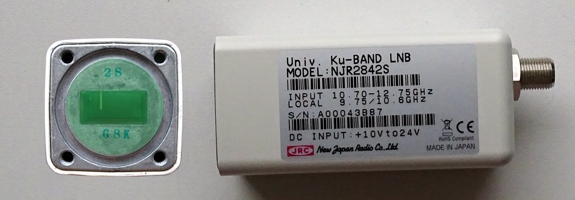Commissioning of the Laminas 2700 dish - the following days
On the third morning, BBC One again operated at 10.5 dB signal strength. That gave me new hope. The reception of the British bond was not a momentary coincidence. Reception was possible, I just had to reveal its laws. And they were quite simple. By the afternoon, the signal strength was increasing, but did not exceed 11.5 dB. Then the signal strength began to decrease again. In the evening around 22:00 the signal was gone again.
The next few days, the sky covered with clouds and began to rain slightly. Although the signals from strong satellites weakened somewhat under these conditions, the weak British alliance, on the other hand, strengthened slightly. Gradually, the signal also appeared in packets that had 0 dB until then. And the packets that disappeared for the night remained with usable signal strength.
By focusing more precisely on these weak signals, I have found that each of the three Astra 2E, 2F and 2G satellites has a maximum somewhere else. Which is right for such a large dish. I started a more systematic work and saved the results in the following table. The problem is that in the azimuth direction, the dish moves too fast. It is difficult to set up short steps with it. It's a bit like the jerky movement of a tank when turning. Practical use shows that in the future, my EGIS positioner control device will need to be supplemented with motor speed control. On the contrary, the movement in the direction of elevation is adequate even for such a large dish, and the direction can be fine-tuned very precisely.
Jevíčko site, Czech Republic, Latitude: 49.6322 °, Longitude: 16.7113 °
LNB Invacom SNF-031
Coaxial cable Belden H125 CU, 45m
Receiver VU+ Ultimo4k, VTI
Data for azimuth and elevation are given in pulses counted by EGIS positioner sensors. For azimuth the conversion is 200 pulses to 1 °, for elevation 800 pulses to 1 °. Unfortunately, the satellite search program only shows the signal strength as a percentage and does not convert it to dB. 100% = 16.0 dB.
The measured values showed that the differences in elevation of all three satellites are in the order of hundredths of a degree. Although it is very small, the direction of the elevation still has a slight effect on the signal strength. However, the difference in azimuth is much more fundamental. According to my direction, the dish reaches a difference of up to 0.45 °. This difference already causes the signal of individual packets to drop to zero. Unfortunately, setting the azimuth with an accuracy of tens of pulses is still problematic for my shooting and only informative.
The indicated signal strength ranges, for example 0 ÷ 31, mean that the strength fluctuates continuously in this range with a period of a few seconds. I don't know what caused it, but such a signal is unusable for reception. The input part of the VU + Duo2 receiver may not be adapted to receive weak signals. I also tried the VU + Ultimo 4k receiver, unfortunately with the same result. I haven't been able to tune in to transponders that have only this range of signal strength on both days.
After gaining these results and experience, I tried the LNB NJR2842S. It is a single-polarity converter that has a rectangular waveguide WR75 at the input. Because the feedhorn has a circular C120 output, it was clear that the two components could not be directly connected. But because the screws of the LNB fit into the holes of the feedhorn and I was curious about this LNB, I tried it.
After tuning in BBC One, the signal strength was only 4 dB. I tried to adjust the skew of the LNB by turning it manually, but to no avail. I tried to check the signal strength on two programs of the European beam with different polarities and both had a signal strength of around 7.2 dB. I attributed this to the fact that the LNB did not adapt to the feedhorn. But it was not true. By turning the LNB again, I tried to set the correct skew and gradually reached a state where one packet with polarity H had a full power of 16 dB and the other packet with polarity V had a power of 0 dB. I returned to the BBC One program and the signal strength was again only 5.2 dB, even though with the Invacom SNF-031 LNB it was 10.5 dB.
Here I can only hope that this situation is really caused by the failure to adapt the LNB waveguide to the feedhorn waveguide. So I decided to buy the Ortho Mode polarization switch, which is also an adaptation from the output interface of the feedhorn C120 to the input waveguide LNB WR75. I wonder how this combination will compare to the Invacom SNF-031 LNB.
8/21/2020 Appendix.
I wrote a separate article here about how it turned out using the Ortho Mode switch: Ortho Mode Transducer






